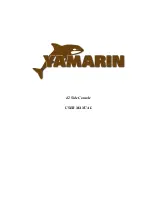
Hobie University, NAHCA
Page 14
30 Mar 02
Start Sailing Right
by Alan Egusa
Reprinted with permission of NAHCA News
Most of this Addendum is now APPENDIX X in the new
US Sailing Level I Small Boat Instructor's
Manual
. NACHA is currently trying to get this material into the upcoming revision of
Start Sailing Right
,
the manual for
US Sailing's beginning sailing
courses.
SAFETY POSITION
(Parking the boat on the water)
1. Release the jib and main sheets, thereby leaving the sails loose.
2. Push the tiller to turn the boat up into the wind. Continue to hold the tiller hard over for as long as you
wish to keep the boat in the Safety Position.
In more breeze the mast may rotate violently from side to side. Slack the downhaul to calm things down.
DIME TACK
(Performed when the boat is stationary or moving very slowly.)
1. Push the tiller hard over as if to turn the boat up into the wind.
2. Grasp the boom or main sheet blocks and pull it to weather until the boat is tacked.
3. Reverse the rudders when the boat moves backwards.
4. Release the sheets leaving the sails loose. You are now in the Safety Position on the other tack.
GETTING OUT OF IRONS
1. Rudders hard over in the Safety Position. (Push the tiller in the direction that you want to sail)
2. Slack the main sheet and traveler, and push the boom out. (Push in the direction that you want to sail)
3. Backwind the jib.
4. When the bows are pointed onto your new course (a minimum of 50 degrees off of the true wind),
straighten the rudders. (A common mistake is not to back around far enough and sail into irons again)
5. Sheet in the jib, then the main sail. (Sheeting in the main too quickly will put you into irons again)
Note: For single-handed catamarans with a main sail, only, ignore references to the jib.
STOP THE BOAT
1. Push the tiller to head up into the wind.
2. Slack the sheets.
3. Push the boom forward to backwind the main sail. Also, backwind the jib.
4. When the boat stops moving, go into the Safety Position.
BACKING UP
1. Stop the boat.
2. If the bows are not pointed into the wind, perform the first two steps of the Dime Tack until they are.
3. Straighten the rudders.
4. Backwind the main sail by pushing the boom forward.
5. Steer with the rudders to keep the boat moving straight downwind.
Note: Backing up puts a lot of pressure on the rudders, so hold on tight and make small corrections
















































